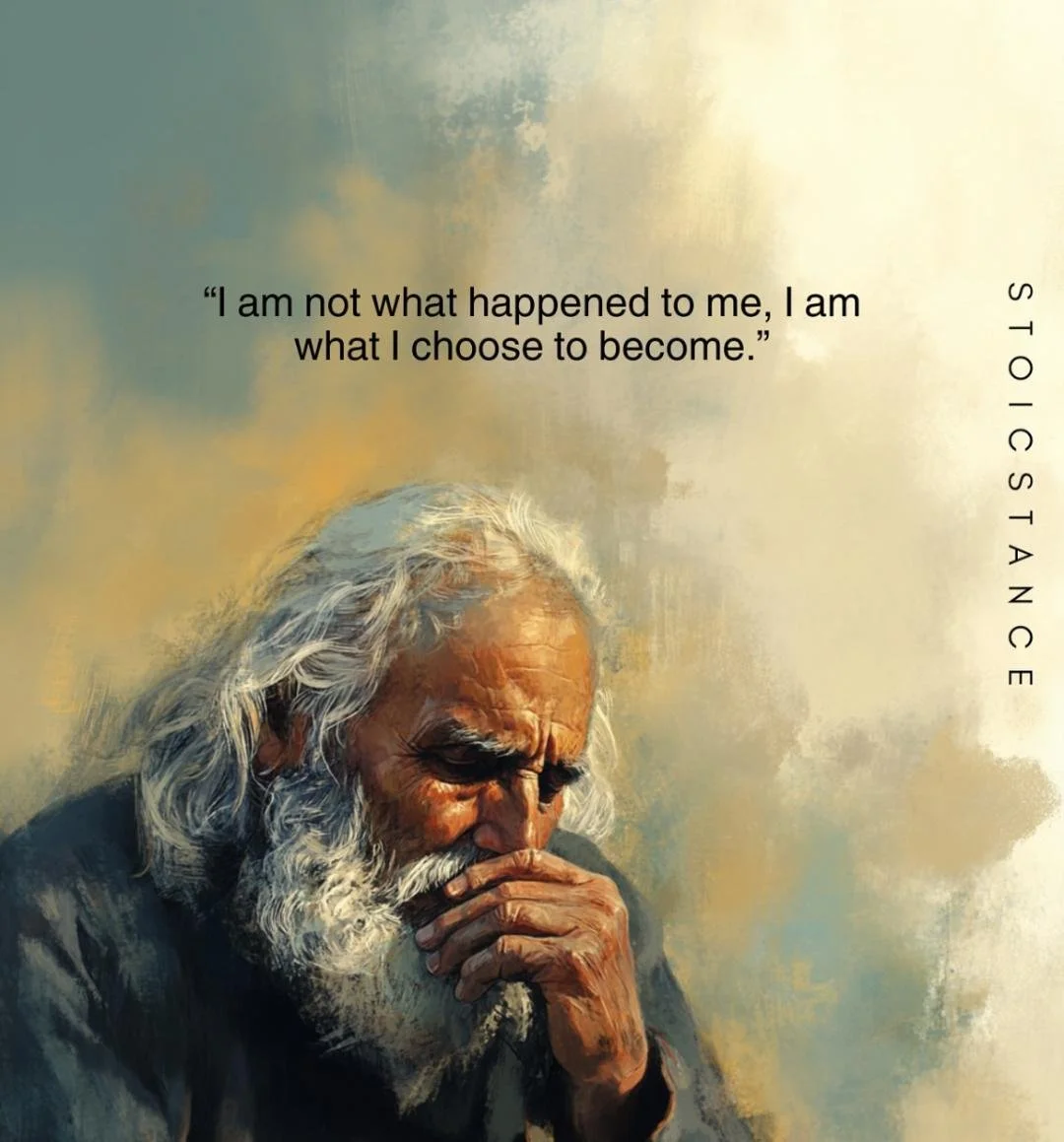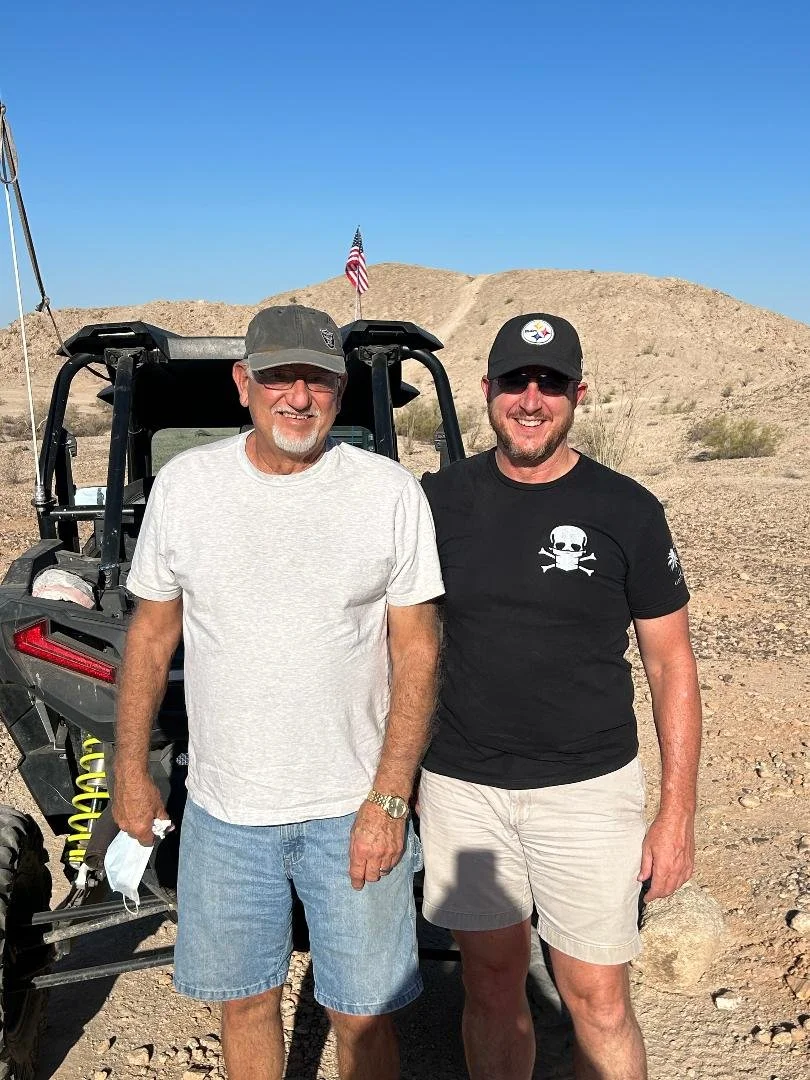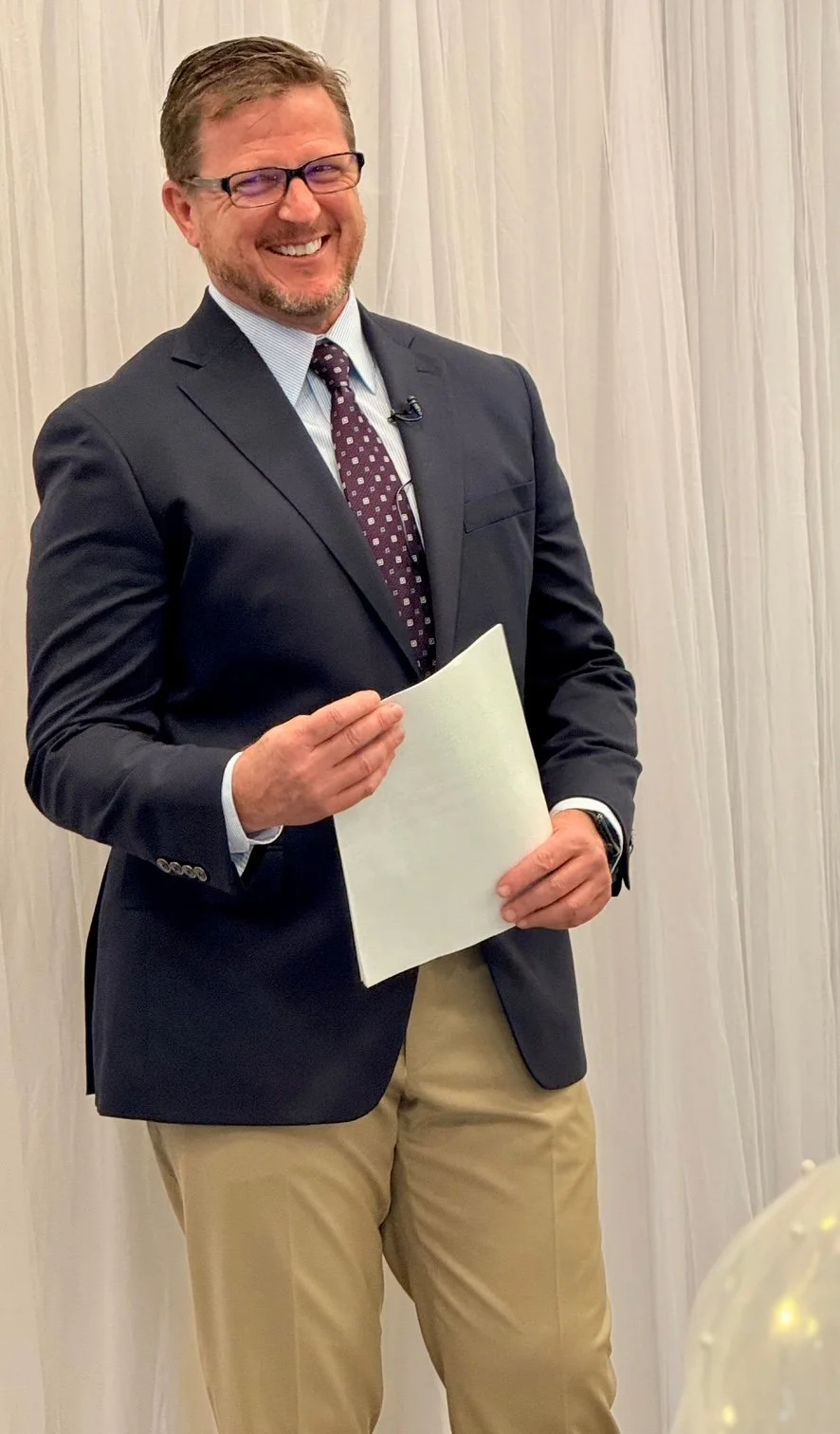
BLOG POSTS
Beyond the Past: Choosing Who You Become
When was the last time you faced a pivotal moment or challenge that left you contemplating your life choices and unsure of your next steps? If you’ve pursued excellence for any length of time, you have likely experienced several of these. They can stem from unexpected setbacks, such as a project's failure, a difficult reorganization, or a significant challenge that impacts your professional or personal life.
It's in these moments that you face a critical choice: do you allow what happened to you to define who you are, or do you use it as a foundation for who you choose to become? This distinction is the bedrock of true leadership and enduring professional and personal significance. As the STOICSTANCE account on Instagram so aptly puts it, "You are not what happened to you; you are what you choose to become."
The temptation is strong to get caught up in the "could have, should have, would have" thoughts. However, the power of this mindset lies in its profound reframing of your identity. It shifts your perspective from one of a passive recipient of circumstance to one of an agent. It acknowledges that pain, disappointment, and failure are real and impactful, but it refuses to grant them the final say in your story.
For a leader, this isn't just a personal mantra; it's a model of resilience that inspires an entire team, family, and community. By demonstrating setbacks are not destinations but detours, you empower those you lead to navigate their own challenges with clarity and courage.
Embracing this philosophy requires intentional, deliberate, and continuous practice. It demands that you consciously separate the facts of an event from the narrative you build around it. While this is not easy, it is about actively choosing your response, your mindset, and your next action, rather than letting the inertia of frustration or defeat guide your path. This is the difference between simply moving on from an experience and truly learning and growing from it.
Here are four deliberate choices you can make to embrace this mindset:
Confront the Narrative, Not Just the Event: Acknowledge what happened, but then consciously challenge the story you are telling yourself about it. Is it a story of failure or a story of learning?
Reframe the Setback as Data: View the difficult experience as invaluable information. What did it teach you about your strategy, your team, or your own capabilities?
Actively Define Your Next Self: Instead of waiting for a new role or opportunity to define you, proactively decide who you want to be next. What skills will you cultivate? What kind of leader will you be?
Take Deliberate Action: Based on your chosen identity, create a specific action plan. Every small step you take to pursue that plan reinforces your choice and proves that you are in control of your future.
Ultimately, the most successful and respected professionals are not those who have avoided hardship, but those who have slowed down, processed the lessons, and mastered the art of transformation. They understand that their value is not diminished by what they have endured. It is, in fact, strengthened by the choices they make in its wake. By choosing to become more than what has happened to you, you secure not only your own future but also a legacy of resilience and purpose.
The Enduring Legacy: How My Dad's Lessons Became My Leadership Foundation
Picture taken Father’s Day Weekend, June 2023
For any leader, the most profound lessons often don't come from a business school or a textbook. They are forged in the crucible of life and taught by the people who shape us most. For me, many of those lessons came from my dad, a man whose strength and character became the bedrock of my own leadership philosophy.
A while back, when I was on vacation visiting my stepson and his family in Puerto Vallarta, we were talking, and he made a comment that captured the essence of my dad's impact. He told me about how much influence I had on his life and how he saw me as an anchor for him. It was a simple statement, but it carried a profound weight. It wasn't about being perfect; it was about the legacy of being a balanced, hardworking, and strong man—a legacy that started with the man who chose to be my dad.
The Lessons of Character
My father consistently treated me as his own flesh and blood, a gift that forged my earliest and most cherished memories. He didn't have to adopt me and raise me as his son, but he did it anyway. His decision was a living testament to a truth I carry with me every day: true family is built on love, not just on blood. This is a powerful lesson for any leader. It taught me that genuine leadership isn’t about a title or a hierarchy; it’s about a choice—the choice to invest in people as if they are your own, to see their potential, and to commit to their success.
My dad also taught me practical, invaluable skills that went beyond the surface. He taught me to hunt, to fish, and to work on my own vehicles and home. But beneath these practical lessons was a deeper truth about resilience and self-reliance. I learned how to work hard and to be the hardest worker on the job, a quality that is now a core part of my professional identity.
Overcoming Fear, Building Trust
Perhaps the most important lesson I learned was about overcoming fear. I vividly remember the persistence he showed me while teaching me to waterski. It took me a long time to get past my fear, but his patience and encouragement paid off. In my life, and in my career, I've seen this lesson play out countless times. As a leader, it's my job to help others overcome their fears—the fear of a new project, the fear of failure, or the fear of a difficult conversation. It’s not about forcing people past their limits but about providing the steady, persistent support that allows them to find their own courage.
My dad’s legacy is not just about the man he raised; it's about the legacy that I am now passing on to my own children. The balanced, hardworking, and strong man he molded me into is the same foundation I’ve been able to give my three kids. This is the ultimate measure of success for any leader: not just to achieve your own goals, but to empower others with the tools, values, and character to achieve theirs.
In a world that often values success over significance, my dad’s influence reminds me that the most enduring legacy is the one we build in the lives of others. It’s the quiet, consistent effort we make every day that truly leaves a lasting impact on our family, our coworkers, and our friends.
Nothing is Hard Forever: The Truth About Enduring Struggle
In this final piece of my series, "Navigating the Uncharted: Lessons from My Job Search Journey," I want to show you that struggles, strife, and difficulties will eventually come to an end. The path may not unfold as we expect, and relief rarely arrives as quickly as we'd like. But when we finally emerge on the other side, we can look back and understand the experience as "the refiner's fire." The struggle was a process, taking us from something unvarnished and raw to a more complete and resilient version of ourselves. The journey is not over, but that particular trial is behind us.
My own seven-month search for a new role ended with an exciting new opportunity at Dun & Bradstreet. Like my experience, your struggles will also culminate in a moment of triumph. With that truth as our backdrop, let's explore the core idea for today's post.
In the midst of a daunting challenge, when the pressure mounts and the finish line seems impossibly distant, an insidious lie often takes root in our minds: that the pain or struggle will go on forever. We tell ourselves it's unbearable, that the discomfort is endless, and that there's no relief in sight. But that is a lie. It's a crucial truth to internalize, both as individuals and as leaders: nothing is hard forever.
Every challenge, no matter how intimidating, has a peak. Every struggle, no matter how intense, eventually subsides or transforms. Our spirit and strength, when committed, possess an incredible capacity for adaptation and growth. This isn't naive optimism; it's a fundamental reality of perseverance.
In these moments of profound discomfort, when the "voices in our heads" are at their loudest, you are presented with a stark, yet empowering choice. Consider these three options:
You can choose to quit. The immediate pressure will ease. The discomfort will dissipate. But the desired destination will remain out of reach, the lessons unlearned, and the potential for growth unrealized. This is the path of immediate relief, but ultimately falls short of overcoming.
It gets easier. As you persist, something remarkable happens. Your skills sharpen, your understanding deepens, and the once-formidable obstacles begin to feel less disheartening. The path itself doesn't necessarily change its terrain, but your capacity to navigate it grows. What once seemed impossible becomes merely difficult, then challenging, then manageable. This is the power of consistent effort, simply taking the next step, then the next, and persistently moving forward no matter how slow.
You get harder. More accurately, you get stronger, more resilient, and more capable. The struggle builds your internal fortitude, callousing your mind and spirit in the best possible way. You become more robust, better equipped for future challenges, and more confident in your ability to endure. This is the profound transformation that only sustained effort can bring.
The Only Way You Lose:
The profound truth is this: the only way you truly lose is if you quit before seeing it through. Every moment of discomfort, every whisper of doubt, every urge to give up is a test. If you yield, the opportunity for growth, for achievement, for becoming "harder" (stronger), is lost. If you push through, if you refuse to surrender to the temporary nature of the pain, you unlock a deeper level of capability and satisfaction.
As leaders, embracing this truth is vital. We must not only internalize it for ourselves but also instill it in those we guide. When our families or teams face seemingly insurmountable obstacles, it's our role to remind them that the current difficulty is not permanent. We empower them by:
Acknowledging the struggle, but refuting the lie of permanence.
Highlighting past successes where they pushed through.
Focusing on incremental progress and the growth they are experiencing.
Modeling perseverance ourselves.
The "long way" demands tenacity, but it promises a reward that the shortcut can never deliver: the profound satisfaction of enduring, adapting, and ultimately achieving what truly matters. It's the knowledge that you faced the storm, and you emerged stronger. Because nothing, truly, is hard forever.
The Long Way is the Shortcut: Why True Progress Requires Patience
In my ongoing series, "Navigating the Uncharted: Lessons from My Job Search Journey," I continue with the lessons learned from my experience. We've explored the initial shock of the job search, the crucible of growth found in adversity, and the enduring impact of that experience. Now, we turn our attention to a powerful truth that often runs counter to popular culture: the long way is the shortcut, because the shortcut never gets you there.
This statement reveals a profound wisdom: genuine, sustainable success and deep, meaningful impact are rarely achieved through expediency. Shortcuts, by their very nature, bypass the essential processes of learning, building, and refining. They might offer temporary gains, but they inevitably lead to superficial results, missed foundational lessons, and ultimately, a failure to reach the desired destination or to sustain it if reached.
Consider this principle across various facets of life and leadership:
In Your Career and Work: The "shortcut" might tempt you to cut corners on a project, avoid difficult feedback, or seek a rapid promotion without truly mastering your current role. The "long way" involves meticulously developing skills, building genuine relationships, taking ownership of mistakes, and consistently delivering high-quality work. While the latter might seem slower, it builds a robust foundation of competence and trust that leads to lasting career progression and meaningful impact. The shortcut, in contrast, often leads to exposure, burnout, or stagnation.
In Family and Friendships: In relationships, you might desire to avoid honest conversations, neglect consistent effort, or seek immediate gratification without investing in mutual understanding and support. This can manifest in a desire to "win" an argument, teaching yourself that you are in a relationship where there must be both a “winner” and a "loser." The "long way" is showing up consistently, practicing active listening, offering unconditional support, and honestly navigating conflicts with patience and empathy. This deliberate effort builds unbreakable bonds and deep trust that no quick fix can replicate.
In Community Building: Here, "community" refers to the group of people with whom you share life experiences. Here, a "shortcut" impact might involve grand, superficial gestures and promises without genuine engagement, or implementing solutions without understanding root causes and downstream effects. The "long way" means patiently listening to the needs of those in your care, building consensus where reasonable, fostering buy-in for initiatives, and showing commitment to sustained effort over years, even decades. This slower, more deliberate approach creates a truly resilient and empowered cohort.
In Personal Growth: You might be seeking quick self-help fads or avoiding introspection. It could also be the use of anabolic steroids to quicken visible muscle gain. The "long way" is the disciplined practice of self-awareness, confronting uncomfortable truths, consistently working on your weaknesses, and embracing continuous learning and persistent work. This arduous journey leads to genuine character development and a profound understanding of self.
Why the Long Way is the True Shortcut
The "long way" is the shortcut because it:
Builds Foundational Strength: It ensures you acquire the necessary skills, knowledge, tenacity, and character traits that are indispensable for sustained success.
Cultivates Resilience: Navigating challenges, the "long way" develops the grit and adaptability needed to overcome inevitable future obstacles.
Fosters Authenticity and Trust: People recognize and value genuine effort and integrity. The long way builds credibility that shortcuts can never achieve.
Leads to Deeper Understanding: True mastery comes from grappling with complexities, not from skimming the surface.
Ensures Sustainability: What is built slowly and deliberately tends to last. Shortcuts often lead to fragile structures that collapse under pressure.
As leaders, it is our responsibility to embody this principle and instill it in those we care for and lead. We must resist the pervasive cultural pressure for instant gratification and instead champion the value of diligent, patient, and thorough work. By embracing the "long way," we not only achieve our goals more effectively but also build stronger teams, deeper relationships, and a more resilient foundation for future success. It is the only path that truly gets us there.
Navigating the Uncharted: Lessons from My Job Search Journey
Many of you who know me well also know that, through a series of unforeseen circumstances, I have been intently pursuing the next significant step in my career. My journey began unexpectedly in January when I was caught up in a Reduction In Force (RIF) at Argano. Since then, it has been a period of intense activity, profound learning, and, at times, significant emotional struggle.
Since January 3rd, I have applied to well over 750 job postings. This sheer volume has provided a unique vantage point into our current hiring landscape. I've spent these past months actively engaging with my network, making personal contact with many of you, and forging new connections. I've had countless conversations, some leading to moments where I thought for sure I had landed that next great opportunity, only to be met with the disappointment of a different outcome. As I review the hundreds of roles I've applied for, each one a hopeful step forward, I'm reminded of the sheer scale and often unpredictable nature of this terrain.
This journey has illuminated some systemic realities of today's job market that are worth discussing:
The Unseen Gatekeepers: Application screening technology is often the first hurdle. HR teams (sometimes called "People Success" teams) increasingly rely on these tools, which, while efficient, often filter out highly qualified candidates before a human even sees their application. This lack of human interaction at the initial stage can be a significant barrier for many.
The Illusion of Opportunity: I've observed that not all job postings represent genuine, open positions. There are often two common scenarios, both of which can create misleading impressions and leave applicants with false hope:
Identified Candidates: Companies may have policies requiring external job listings, even when a hiring manager has already identified a candidate for the role. This practice, while often policy-driven, can inadvertently create negative impacts. The identified candidate may get hired by another organization due to unnecessary delays, leaving the hiring manager without the team member they knew they could trust. Meanwhile, applicants (both internal and external) who genuinely match the criteria invest time and hope in a role that was never truly available. These are just two of the negative impacts I am highlighting; there are several more.
Market Research: Particularly with consulting firms, job postings can sometimes be used to gauge market salary expectations for potential future projects, rather than for immediate hiring. When a company chooses to post a listing without a genuine intent to hire, it creates a misleading impression for the job market and the broader business community. While sometimes labeled a "common practice," it raises questions about transparency. As I reflected in my recent post on avoiding Groupthink, blindly following such practices can inadvertently erode trust in the very organizations People Success teams represent.
The Silence of the Process: Roughly 65-70% of all the job postings I applied for yielded no feedback whatsoever regarding the reason for non-selection. This lack of communication, while perhaps efficient for recruiters, leaves applicants without crucial insight and, frankly, without the common courtesy of a response after their time and effort invested.
The Power of Connection: Navigating these automated screens and opaque processes has underscored a crucial lesson: having and making personal connections is more vital than ever. It's often the essential step to bypass the technical filters and gain genuine human interaction. As part of your consideration of applying to a job listing, I encourage you to check out the hiring company and its leadership team. Most of the time, you can do that on the company’s website. See if there is something in the company’s publications, blog posts, or LinkedIn threads where you can help the leadership team know that you can help resolve a specific hurdle they may be facing. Consider writing a professional email and/or LinkedIn invitation for connection with your personalized note on how you can help them achieve their goals.
In the end. I have landed my next job. More on that later.
Over these next four weeks, I will be sharing a series of posts on the lessons I have had to learn, absorb, and apply in my own life throughout this journey. These are not just theoretical concepts; they are insights forged in the crucible of real-world experience, in the moments of hope, the depths of frustration, and yes, even times of despair.
I am sharing this today to let all who read these posts know that this series is as much self-talk and self-help for me as it is intended to guide and support others who may be navigating similar difficult terrain. I hope that by openly discussing these lessons – from pushing through discomfort, anger, angst, and even bitterness when things feel unbearable, to understanding why the "long way" is often the true shortcut – we can all find strength, clarity, and resilience on our paths.
Stay tuned for the first post next week.




